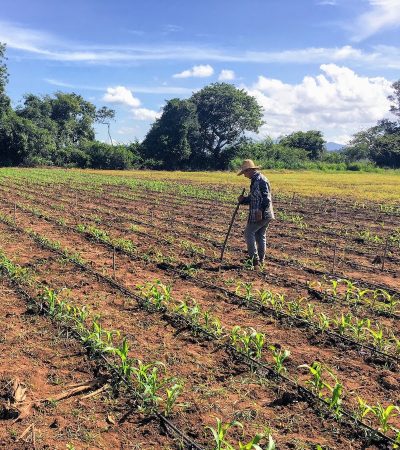
How a Coffee Farmers Group Empowered One Guatemalan Woman to Lead
When she was a little girl, María Juan Tomas often helped her father with the family’s coffee farm in Guatemala. One day, she thought, she’d have her own plot of…
Read MoreUSAID/Guatemala’s Climate, Nature and Communities in Guatemala (CNCG) Program is piloting a project to promote climate-smart agricultural practices in Guatemala’s Western Highlands. These practices, which are part of CNCG’s broader strategy to increase the resilience of communities, producers and government institutions, promote the resilience of agricultural systems while bolstering food security and livelihoods.
Technical specialists and producers from 10 organizations in the Western Highlands—the region most vulnerable to climate change in Guatemala, and home to the country’s highest indices of poverty and malnutrition—are learning to apply adaptation measures within demonstration sites. Participants in this pilot program are selected within the framework of the USAID/Guatemala Rural Value Chains Project.
To counter the environmental and economic impacts of climate variability in the Western Highlands, Climate, Nature and Communities in Guatemala is implementing site-specific adaptation measures in each demonstration site. These measures are being applied to address the unique challenges each producer organization faces, with the goal of increasing the resilience of agricultural systems. The Climate, Nature and Communities in Guatemala Program has designed a range of interventions to meet the current and projected needs of each group.
In zones experiencing prolonged periods of drought (or in zones that anticipate this challenge), the program promotes the use of rainwater catchment systems to ensure an adequate water supply for agricultural and household use. This simple solution will help communities to weather periods of drought by more efficiently using this resource.
Conversely, in zones experiencing intense rainfall over a short period (or in zones that anticipate this challenge), the program is promoting such soil conservation methods as live and dead barriers (strips of vegetation or non-living material that anchor soil in place and slow the movement of water downslope), and terrace channels to prevent runoff and soil erosion on the steep slopes of the Western Highlands.
In zones experiencing increased frosts, the program is supporting the installation of macro and micro tunnels to shelter and prevent damage to crops.
Beyond these specific interventions, the Climate, Nature and Communities in Guatemala Program promotes the use of climate-resilient crop varieties across the board. The sum total of these efforts is a holistic approach that addresses climate change and food security.
To date, producers have enthusiastically adopted climate-smart agricultural techniques, with practices underway in four demonstration sites throughout the Western Highlands: Magdalena, Chiantla, Huhuetenango; El Limón, Todos Santos Cuchumatán; Tojcoral, Concepción Chiquirichapa, Quezaltenango; and Río Negro, San Pablo, San Marcos. In the coming months, the Climate, Nature and Communities in Guatemala Program will add six demonstration sites as part of an ongoing response to the challenges of climate change.
The Climate, Nature and Communities in Guatemala Program (CNCG) is not funded by Feed the Future; however, Feed the Future funds members of the consortium of environmental, academic and business institutions that implement the program. CNCG is implemented by a consortium led by Rainforest Alliance and which includes the World Wildlife Fund, The Nature Conservancy, Universidad del Valle (University of the Valley), Defensores de la Naturaleza, and AGEXPORT.
When she was a little girl, María Juan Tomas often helped her father with the family’s coffee farm in Guatemala. One day, she thought, she’d have her own plot of…
Read MoreFor many developing nations grappling with climate shocks, chronic droughts are a familiar problem. In Guatemala, recurrent dry spells are a leading cause of soil degradation and food-supply shortages, forcing…
Read MoreThis article in brief: While cacao is a high-value crop in Guatemala, indigenous leadership of an export enterprise is rare, and indigenous women’s leadership is even more scarce. The Inter-American…
Read MoreThis article in brief: Guatemala has high rates of malnutrition, with 46 percent of children suffering from stunting. The main reason for these high statistics is that traditional maize, a…
Read More
